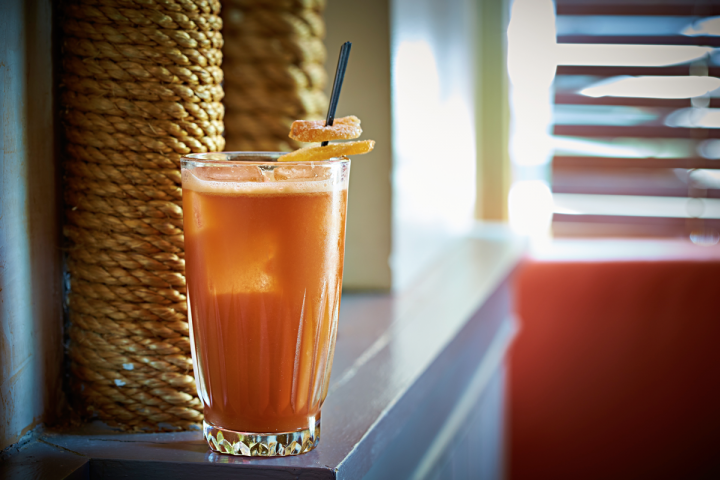
In the search for untapped flavor profiles and new ingredients to give their cocktails an edge, many mixologists have turned to aquavit. Usually bottled between 40-percent and 45-percent alcohol-by-volume, the traditionally Scandinavian spirit with a prominent caraway flavor has historically been consumed like schnapps—chilled and neat in a small glass. But aquavit’s use as a cocktail component shows off its versatility.
“I’ve had people tell me it’s sacrilege to do anything other than drink aquavit straight,” says Sonja Kassebaum, cofounder of North Shore Distillery in Lake Bluff, Illinois. The company debuted its Private Reserve aquavit ($29.99 a 750-ml. bottle) in 2006 and received a warm welcome from Chicago’s bar scene. “For bartenders, it’s a rich tool—something they can layer flavors upon,” Kassebaum explains. At North Shore’s on-site bar, guests can substitute aquavit for vodka in a Bloody Mary or in a Moscow Mule variation called the Nordic Mule. The distillery also offers one of the few classic cocktails made with aquavit, the Midnight Sun, which combines the spirit with grapefruit and lemon juices, simple syrup, and grenadine. “What’s interesting is that it tastes one way at first, and as it warms up, the aquavit comes out a little more,” Kassebaum says. She notes that since Private Reserve is barrel-aged, it offers richer flavors than unaged varieties.
At New York City’s Wallflower bar, owner and mixologist Xavier Herit uses aquavit often. “It brings a different flavor to cocktails,” he says. “Aquavit falls between vodka and gin—its profile isn’t as strong as the juniper and botanicals in a gin, but it’s not as mild as vodka.” This past summer, Herit featured aquavit in two cocktails: the Sho Sho ($15), which comprised Linie aquavit, Gutierrez Colosia Oloroso Sherry, house-made carrot-ginger syrup, lime juice and Virgil’s root beer, and the Stockholm Syndrome ($14), mixing Linie aquavit, cumin- and dill-infused Reyka vodka, lemon juice, salt, black pepper and Peychaud’s bitters. Originally created by Alex Skärlén and Thor Bergquist of the Experimental Cocktail Club in London, the Stockholm Syndrome made up about 20 percent of sales while it was on the menu at Wallflower. “Customers sometimes need a little explanation of aquavit, but once people have a taste, they like it,” Herit says.
Portland, Oregon–based bartender Jacob Grier discovered aquavit several years ago and became such a fan of the spirit that he founded Aquavit Week in 2012. “It started as a way to showcase different aquavits both neat and in cocktails,” he explains. “With so many botanicals in aquavit, there’s no single kind of cocktail that works. Bartenders are exploring its versatility.” Grier notes the variations between imported and American-made aquavit. “In Scandinavia, it’s produced for people to drink straight, whereas here in the United States, aquavit is more of a cocktail ingredient,” he says. “The flavors of American aquavits tend to stand out more.” One of Grier’s favorite uses of aquavit is a Hot Toddy, made with locally produced Krogstad Gamle aquavit, homemade Swedish punsch, lemon juice and hot water, with a star anise garnish. This December, Grier plans to expand Aquavit Week to cities beyond Portland, with brands like the Icelandic aquavit Brennivín supporting the event.
At Hecho en Dumbo restaurant in New York’s East Village, head bartender Ethan Smith uses aquavit as a way to play off the herbaceous flavors of chef Danny Mena’s Mexican cuisine. “He uses a lot of earthy ingredients that aren’t familiar to the American palate, such as epazote, avocado leaf and corn masa,” Smith notes. “Those flavors make a great foundation for aquavit cocktails. Just a little bit of aquavit gives the drink an extra dimension and makes it unique.” Smith’s Campo de Oro cocktail ($14) features Krogstad Festlig aquavit, Bombay Sapphire gin, Bittermens Orchard Street Celery shrub, house-made thyme syrup, lemon juice and Peychaud’s bitters.
With its unusual flavor profile, aquavit has typically been a niche product. But there are signs that it’s on the cusp of more widespread consumption. “More bars are picking up aquavit and recognizing that it’s a spirit with a lot of variability,” says Portland’s Grier. “They’re starting to understand and explore the category’s potential.”